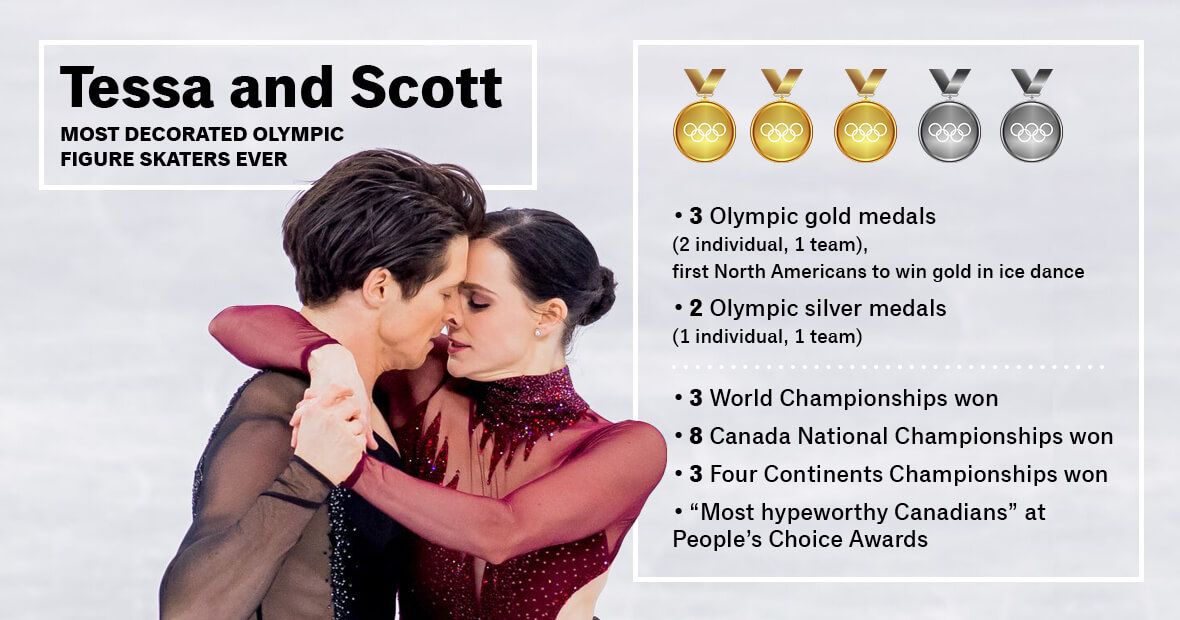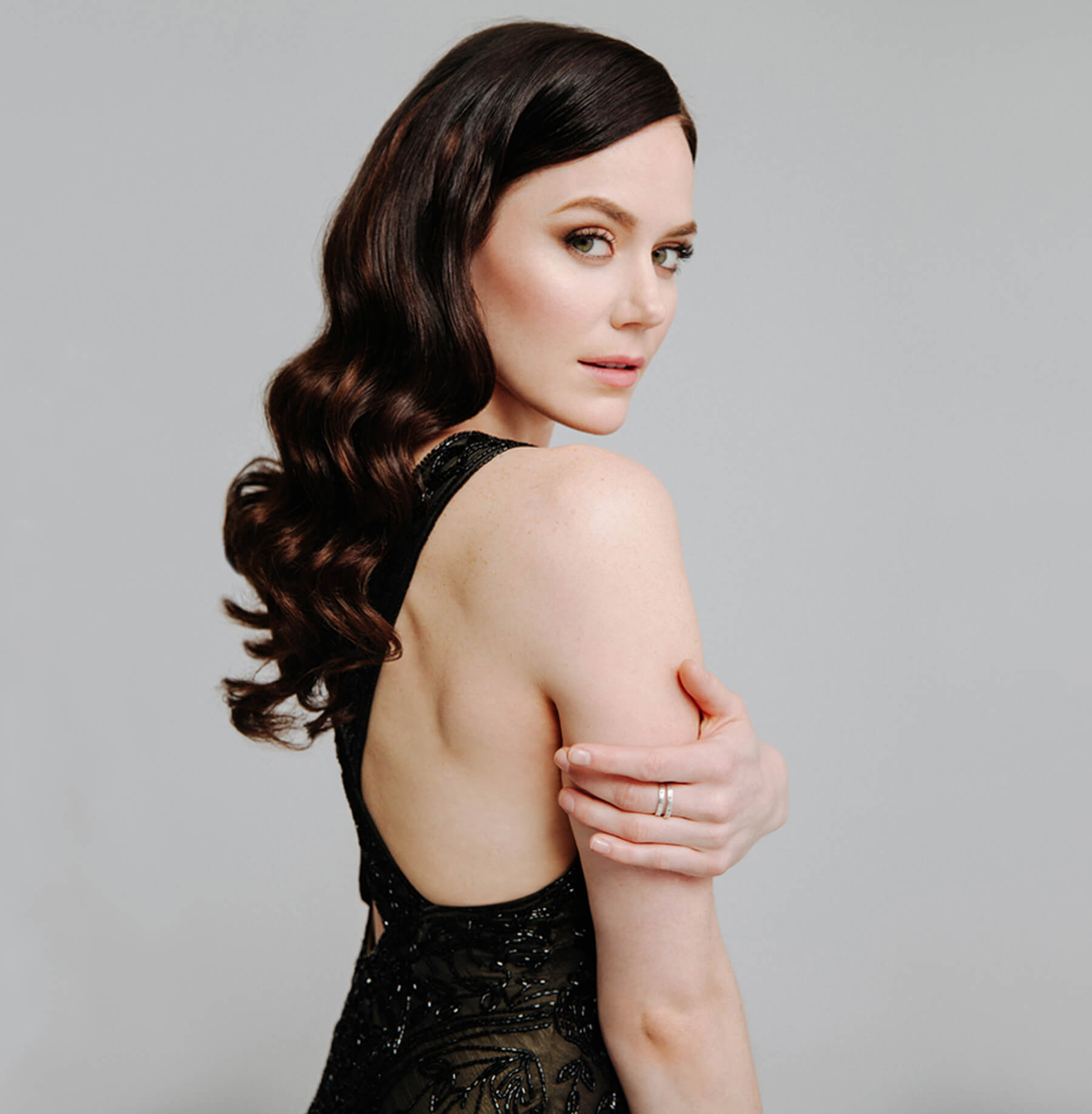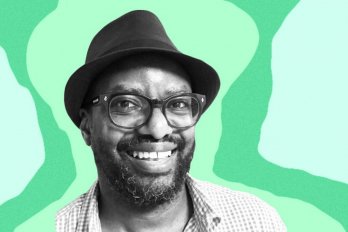Tessa Virtue seems frozen in time. Forever twenty-eight, forever dressed as the fated seductress Satine from Baz Luhrmann’s Moulin Rouge! in a sparkling, backless, slit-to-the-hip burgundy dress. Her legs are perpetually wound around skating partner Scott Moir’s thigh, or his hips, or, famously, his face, in the practically pornographic lift she says they learned from an acrobat. Photos from the day Virtue and Moir won gold for Canada in ice dance illustrate nearly every news and non-news story about the pair since, of which there are so many that superfans call discovering the cache of content “falling down the rabbit hole.”
Even now, video of their victory at the 2018 Winter Olympics in Pyeongchang, South Korea—their final Olympic Games—is still being watched and shared online. There she is: trembling down to her skates, smile splitting her face in half, hands coming up to cover her mouth. He roars and scoops her up, lifts her high, buries his face into her neck. Minutes later, they snagged their second gold medal of the games, after the team event, becoming the most decorated Olympic figure skaters of all time.
That was February 20, 2018. It’s been quite a year—possibly the busiest of Tessa Virtue’s young life. She’s spent much of it trying to define herself beyond that golden moment at the games—a daunting goal. Since the Olympics, Virtue and Moir have been riding a wave of national and international media and fan attention that has yet to crest. In the spring, they led the Stars on Ice Canada tour to its best sales in fifteen years and skated in months of shows in Japan and South Korea. In the summer, they threw a county-fair-style victory bash in Moir’s hometown to thank their families, friends, and fans. In the fall, they published an update to their 2010 biography, Tessa & Scott: Our Journey from Childhood Dream to Gold, and travelled across Canada again as coproducers of their own show, the Thank You Canada Tour.
And, while Moir has retreated more to private life, disappearing from the public eye for months at a time, Virtue has ascended from the realm of famousish Canadian to actual celebrity. She was the most mentioned Canadian female athlete on Twitter last year and the most googled Canadian in Canada, period. She’s appeared in major magazines, from Canadian Living to Vogue Japan, and has launched a career lending her image to megabrands such as Nivea, Adidas, meal-kit service Hello Fresh, the Brick, and Air Miles, with more deals in the works. Fame has propelled her to a natural series of next steps: influencer, show skater and producer, social-media maven. Yet none of those labels feels like a perfect fit to her. Then again, neither does “Olympic figure skater.”
Over the course of ten months, starting shortly after her 2018 win, I had many conversations with Virtue in person, by email, and over the phone. I watched her perform in skating shows and talk shows and spoke with her teammates, mother, and friends. In that time, I saw a person who, after pursuing a goal with relentless focus for two decades, is grappling with what it means to let it go and face whatever’s next. Sports psychologists call it the “Olympic comedown”—that moment after the competition ends and an athlete realizes the one thing that defined their day-to-day-life no longer does. During one interview, we started half-seriously drafting Virtue’s obituary, knowing that, at just shy of thirty, she has almost certainly already lived its first line. “Whatever I take on next, I’m never going to be the best in the world,” she says. “How will I get that rush when it’s not the Olympic Games?”

I first met Tessa Virtue at a Toronto PR event in March 2018, where she was celebrating her debut as a brand ambassador for Nivea. Gaggles of beauty bloggers and influencers filled a swanky venue replete with photo-friendly backdrops: a doughnut wall, oversized blue and silver balloons, and an ice-sculpture replica of a tin of Nivea cream. Virtue’s outfit—powder-blue pantsuit, fuchsia lipstick, artfully messy braid—suggested Queen Elsa from Disney’s Frozen. But she was pale under Instagram-optimized makeup, and her smile did not quite reach the tightness around her eyes. She’d been home from the Olympics for about a week and had spent much of it sick in bed, insulated from the media firestorm. It was bound to settle down soon, she told me. People would move on.
They didn’t. Still haven’t. Instead, Virtue found herself in a new reality, at once gratifying and terrifying, in which just going to the grocery store or getting gas is, “like, a thing.” It’s not her first brush with fame: Virtue and Moir have been household names since their first gold at the Vancouver Winter Olympics in 2010, and they even starred in a reality series ahead of Sochi in 2014. This time, though, it’s different. Fame itself has changed. The pair have spawned a full-fledged internet subculture with its own lingo, in-jokes, art, and fanfiction.
The outpouring of love has been touching, Virtue says. After one fan coordinated a video project that saw more than 100 people from over twenty countries film themselves wishing her a happy birthday, she called her mom, crying happy, overwhelmed tears. It’s also a lot of pressure: one group of girls showed up to a postshow meet-and-greet carrying phone cases with the slogan WWTVD for What Would Tessa Virtue Do? The clear subtext: we should all do what Tessa Virtue does, because Tessa Virtue does everything right.
Virtue strives to embody the values of the Olympic movement. Fans revere her winning combination of skill, beauty, and sweetness. But maintaining that public persona is a minefield of double standards. It seems like she is expected to be a paragon of Canadian niceness. To be a role model but also be real. Beautiful but relatable. Sexy but not too sexual. Her Instagram is a pink-tinged utopia of fresh-cut flowers, heart hands, sponsor posts, inspirational quotes, and white-bread, girl-power feminism. A few selfies, some skating, not much #RealTalk. Though she is deeply concerned about authenticity, she peppers her interviews with stock phrases: “incredible honour,” “what a thrill,” “wonderfully heartwarming.” Once, when I pointed this habit out to her, she grumbled that the support she and Moir have gotten from Canadians is wonderfully heartwarming. Later, she caught herself saying it again and sniped, “You can put that quote in!”
Behind the scenes, even Virtue herself doesn’t always know the answer to WWTVD. After a semi-trailer crashed into a coach bus on a stretch of highway in Saskatchewan, killing sixteen people, many of them members of Humboldt Broncos junior ice hockey team, Moir posted a short message of remembrance on his rarely used Twitter account. Virtue, though, was uncharacteristically silent. She wrote and rewrote social-media posts, saving and erasing drafts, before finally deciding too much time had passed. She was thinking about her first boyfriend, a one-time star of the OHL’s London Knights. At seventeen, a disaster like this would have derailed her life. She felt so acutely for those left behind but didn’t want to come off as “totally self-absorbed.” It felt wrong to get likes or retweets for something like that. She donated to a fundraising campaign for the victims’ families but processed her feelings in private.
Her desire to do the right thing—the perfect thing—seems to run deep. And though Virtue says the trait is just part of her personality, it may also be a product of her training. From her earliest years, Virtue was intense and competitive, reaching elite levels in skating and dance. She says that, at nine, she was a “perfect candidate” at the National Ballet School’s camp, which functions as a weeks-long, live-in audition for its academic program. Virtue was obsessed—in a way that might seem unhealthy, she says now—with making sure she was good enough. There’s an entry in her diary from that summer about the time her flawless ballerina bun came unglued, how bad she felt, and how she apologized to the teacher, promising it wouldn’t happen again.
Virtue got into the ballet school but chose skating instead. She’d already been partnered with Moir by then. Virtue was born in London, Ontario; Moir grew up in the tiny nearby town of Ilderton, which is the home of the skating club where, in the fall of 1997, Moir’s aunt Carol, the pair’s first coach, asked an eight-year-old Virtue and barely ten-year-old Moir to stand side by side to compare their heights to see if they made a nice match. Before long, people picked up on their potential. Veteran coach and CBC skating writer Pj Kwong remembers watching Virtue and Moir skate at an Ilderton carnival when they were little and thinking, Wow. “You see kids who work hard, kids who have a little something,” she says. “But you don’t often see talent that makes you go, ‘Hmm, I’m interested to see where these two end up.’” They had everything: musicality, technical skills, and that much-discussed connection.
Soon, their parents started driving them to Waterloo, over an hour away, for extra training several times a week. At around thirteen and fifteen, they moved in with families in Waterloo to be closer to their coaches, and then, two years later, to Canton, Michigan, to train under Russian coaches with other Olympic hopefuls. They narrowly missed qualifying for the 2006 Winter Olympics in Turin but took gold at the World Junior Figure Skating Championships the same year.
Then, in 2008, Virtue was diagnosed with chronic exertional compartment syndrome, a severe overuse injury to her lower leg. She had her first surgery to correct it at nineteen, but the pain persisted. Virtue didn’t let herself think she and Moir could go all the way until a month before the Vancouver Winter Olympics were held in 2010.
In their spectacular, gold-medal-winning skate to Mahler’s Symphony No. 5 at the Vancouver Winter Games, Virtue appeared to float around Moir, weightless. Off the ice, just hobbling across a room could be agony on her calves. She kept quiet about the pain during the Olympics, for fear judges would see signs of discomfort in her performance. She underwent another surgery at twenty-one, then did extensive physiotherapy to learn how to skate and even walk differently to manage the injury. When asked if it was all worth it—moving away so young, all those sacrifices—Virtue says yes, she thinks so, but that it doesn’t matter: there was no stopping her or Moir. She also admits she might have said no if asked the same question in 2014, after winning two silver medals at the Sochi Winter Olympics under a pall of allegations that judges and their own coach were biased. But now, with trademark Virtue positivity, she frames the heartache and hiatus after Sochi as a prelude to a final, triumphant comeback.
In the run-up to their final Winter Olympics, Virtue and Moir changed coaches, moved to Montreal, and became the de facto CEOs of Get Scott and Tessa the Gold, Inc. They managed their own schedule and a veritable cottage industry of sports professionals funded by the non-profit B2Ten. They monitored and fine-tuned every aspect of their lives, from food to sleep, and spent hours with a mental prep coach, honing their discipline in preparation for the few minutes of skating that would make or break their Olympic legacy. Virtue learned to quiet competition nerves by telling herself “I’m unstoppable”—whether she always believed it or not. The rise of this kind of targeted investment has undoubtedly helped Team Canada dominate. Virtue and Moir are endlessly grateful for it. But the intensity of the ramp-up has also made the return to regular life all the more jarring. “I don’t think there’s such a thing as a well-balanced athlete, I really don’t,” Virtue says.
Virtue’s mother, Kate, put it this way: “A few weeks before the Olympics, she was telling me she would look at a grape and think, ‘How does this affect my Olympic experience? If I eat it, will that be healthy? Will that help me? If I take time out maybe for an hour and take a walk instead of a nap, will that hurt?’ Every minute of her time mattered.” And then it didn’t. Today, there is no equivalent coaching team to guide Virtue to become the best brand ambassador or social-media superstar. For all her preparation, she always shied away from media training, fearing it would turn her and Moir into “robots.” She wants whatever she does next to be “genuine, not forced.” Though her job is endorsing products, she says she doesn’t want to get “swept up” in crafting a lifestyle brand—it’s not like her to “pretend to be an expert.” She’s a private person, a perfectionist and a malignant people pleaser—ideal traits in Tessa Virtue, Elite Figure Skater, but perhaps not in Tessa Virtue, the Brand.
On a sloppy, snowy evening in April 2018, two months after the Olympics, I met Virtue in the lobby of the downtown hotel where she stays when she’s in Toronto. It’s a grand place. Someone wheels an enormous concert harp across the room as two different bridal parties tarry between ceremony and reception, shivering in skimpy evening gowns. Virtue greets me with a hug, then turns to embrace a concierge, who asks how she slept (twelve hours, she says, the most since the Games). In 2014/15, the first of two seasons she sat out of competition, Virtue packed her schedule with so many media and corporate gigs in the city that she practically lived at this hotel. Once, her mom, who had barely seen her for months, came for a visit and watched as staff met Virtue at the door, exclaiming, “Welcome home, princess!” and “We have your clothes in storage!” “I thought my mom was going to cry,” Virtue says. “Because it was like they were my family.”
As we walk to get dinner at a nearby Italian place, she rattles off a long list of commitments she has squeezed into these few days between the Japanese and Canadian Stars on Ice circuits: an all-day takeover of CTV shows, a keynote speech with Moir at a sports symposium, a marathon twelve-hour interview for their updated book. “I like to be busy. If I can do things, I will. I fill my days. Do you do that?” she asks, adding that she’s looking forward to a vacation in France in August. Wait, August? It’s only April. Doesn’t she need to decompress before then? Well, probably. But she has taken a day off, and it was a “game changer.” One day? In the two months since the Olympics? Yes, she took a single day in Los Angeles when they went to film The Ellen DeGeneres Show. By then, she was starting to fray.
“I bawled my eyes out, because I finally had time to settle,” Virtue says. She knew the emotional crash was coming, and she felt pulled in a million different directions. The tsunami of attention left her reeling. She was in a fog, unable to feel present. What did we just accomplish? What does that mean? She wanted everyone around her to be happy, to feel they had been part of the Virtue-Moir success story, because, to her, they had. She calls training for the Olympics an inherently selfish endeavour, but she neglected, in the aftermath, to take enough time for herself: “I had nothing left.”
As athletes rebound from the physical and psychological high of the Games, “all the stuff that was lingering comes to a head,” says Rolf Wagschal, an advisor with Game Plan, the Canadian sports system’s program to promote athletes’ wellness and help them transition out of competition. He says they often get sick, as Virtue did after the Olympics, and feel blue for a while. But, for some, the unease bleeds into a longer-term, existential struggle, both with practical concerns (“How do I eat like a normal person?” “How do I apply for a job?”) and “big philosophical questions” (“What do I want to be when I grow up?” “Who am I now that this core part of my identity is gone?”).
Game Plan launched in 2015 after an Own the Podium report on the 2010 Games found Canadian athletes were leaving sport feeling ill prepared for adult life. A 2016 review of published studies argued that retiring athletes have above-average rates of depression and anxiety and are less likely than others to seek help. It’s hard for them to talk about. Olympians are, by definition, blessed. Virtue worried aloud that talking about the comedown sounded ungrateful.
Canadian super-Olympian Clara Hughes devotes a whole chapter of her autobiography, Open Heart, Open Mind, to the “toxic inner chatter” that grew unbearably loud without the demands of training to focus her thoughts. Meryl Davis—half of the American ice-dance duo Meryl Davis and Charlie White, who left competition after beating Virtue and Moir for gold in 2014—wrote in Self magazine last May that she’s still feeling the comedown: “After spending my life deep in the pursuit of a dream now realized, I find myself hollow, empty, vacant, and without purpose.” Canadian ice dancer Kaitlyn Weaver, Virtue’s friend and competitor, said one day, not long after the Pyeongchang Winter Games, she started crying on the way home from the rink, contemplating the coming feeling of life post-Olympics and thinking, “Maybe this is it for me.” She worried about the “free fall” after her eventual retirement.
Amid all the rhetoric about how sports are character building and instill transferable skills, it’s easy to gloss over what elite athletes need to unlearn, like perfectionism and single-mindedness. And while many athletes manage to channel the drive they had to chase the gold-medal high into something productive, few seem to be immune to the initial comedown. Take Canadian Olympic kayaker Adam van Koeverden. After struggling with “irrational sadness,” he recently announced plans to run as a Liberal in this year’s federal election.
Moir told me it took him a year to get over the emotional exhaustion after the Vancouver Winter Olympics in 2010, and the letdown after Sochi was worse. He describes running away from the skating world and hiding out in his hometown, not wanting “much to do with anything.” He tried to recapture a youth spent in self-denial with “crazy partying.” He bought a house to fix up. He finally finished high school at twenty-seven. But he was unhappy—until he returned to competitive skating. “I needed that structure back,” he says. “I didn’t know who I was.” Being an expert both in post-Olympic angst and in Tessa Virtue, he says that, after these games, she was not herself. Seeing a little of the “polish” come off Virtue’s persona convinced him something was wrong. As a partner, he says, it was hard to watch.
Like many other top athletes, to function, Virtue needs goals. Preferably too many, preferably all at once. Some post-Olympic athletes, Wagschal says, compulsively fill their days, say yes to everything, and even pursue career paths “out of convenience rather than genuine interest,” just because doing stuff is what they do. They don’t know how to not. Virtue made a new to-do list for her post-skating life during a rare moment at home in London not long after the Games. She says crafting it helped calm her comedown nerves and give her purpose and, as we ate dinner, she gave me a partial rundown. For starters, she wants to create a line of greeting cards, with proceeds going to charity. She’s already written them; she just needs a designer. (“Every city I go to, I’m always shopping for cards. . . . I love having the right card for the right person.”) She wants to do more charity work overall but doesn’t want to jump into anything without first earning “credibility.” She has since signed on to be a mentor with Fitspirit, an organization that promotes girls’ fitness.
Also on the list: do more fashion collaborations. She already has a line with the Montreal eyewear boutique Bonlook and has designed jewellery for Hillberg & Berk. She’s working on a course to finish the last of the psychology degree she’s been chipping away at for over a decade, then plans to pursue an MBA—again, for “credibility.” (She plans to go to Queen’s and wants to start in the fall of 2019. However, she’s also planning another self-produced tour with Moir for that same period—this one far more ambitious, with US stops.) She considered a master’s in psychology, which she says would be personally satisfying and useful no matter what she does. But she decided against it because it “honestly, would just be more for me.” She pictures her future self in a power suit, driving business deals. She’s “obsessed” with real estate. Aside from the Olympics, she says her greatest thrill is negotiating a contract.
Notably missing from the list was one clear next thing. Tessa Virtue’s persona is synonymous with “figure skating,” but that’s not how she sees herself. She has little interest in coaching. She barely paid attention to the World Figure Skating Championships in 2018. She and Moir have pledged to keep their partnership going for two years after the Olympics. They’ll do just one more tour together, then re-evaluate. “I just don’t want to be forty, putting on a costume and entertaining people. I want to do it when I’m in my prime,” Virtue says. “Because if I can’t do it and be at my best, then it doesn’t interest me. If I can’t be the best, then it doesn’t interest me.” So she’s going to hang up her skates for real? “Yeah,” she responds. “Eventually, yeah.”
Pivot Podcast
Tessa Virtue and Scott Moir envision their post-Olympic transition | March 2018 interview
During a phone conversation very late at night in June, after a long day performing in shows in Kanazawa, Japan, Virtue returned to the subject of her Olympic recovery. She’d been feeling “utter exhaustion” from performing their full Olympic program night after night and had teared up unexpectedly during a standing ovation at Stars on Ice in Halifax. A couple of months later, just before the long-awaited French getaway in August, she sent me an email saying, “I’ve grown accustomed to feeling unsettled. It is constant, underlying every conversation and decision—even creeping in on the rare quiet moments.” She was hoping the vacation would help. She originally told me it would be unplugged and phone free, but later said she’d need to be able to talk to the tour team. She was all over Instagram in France, exploring vineyards, floating in a pool, and looking, indeed, quite relaxed.
It was only in November, near the end of the Thank You Canada Tour, that she pronounced herself better. Tentatively. Around the same time, I watched her do a takeover of CTV’s The Social with Moir, where the hosts surprised them with their People’s Choice Award. Virtue and Moir’s fans had outvoted devotees of Shawn Mendes and Drake to crown them, jointly, the “most hypeworthy Canadian” of the year. Virtue, on the spot to make an acceptance speech, reached for a talking point I’ve heard her use before—the “sense of limitlessness” with which her family blessed her. It wasn’t the “nicest” thing for the TV crew to do to them, she told me later. She didn’t have time to prepare.
This moment raised the question of why Virtue is choosing to live a public life at all. Her answer revealed her Olympian drive to go. She says she’s eager to get into the workforce after so many years as amateur athlete, and she needs to take the work that is available—as long as the companies have values she can stand behind. Besides, she’s “obsessed” with work and loves being busy.
The last time I saw Virtue was in December, when she and Moir claimed their star on Canada’s Walk of Fame. As they were welcomed onstage for the ceremony, a photo retrospective of their career flashed up behind them. I counted eight pictures of Virtue in the burgundy dress from the Moulin Rouge! program. It’s the moment that turned her into an icon, the one she’s trying to move on from—even if we never do. She knows it sounds arrogant to say so, but she’s pretty sure she’ll succeed at whatever she decides to do next. That might be a naive, overoptimistic, or even privileged point of view. But it’s coming from someone who has earned the title “best in the world” a few times already. She says she doesn’t expect to be handed her next win or feel entitled to it. She’ll work for it—as hard as she needs to. Tessa Virtue never quits.




